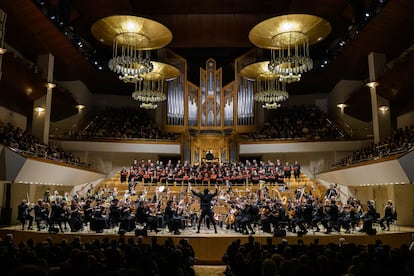“I would like to have new ideas, but you can’t forget what music tells you,” he acknowledged last Monday The Times The legendary Riccardo Muti. And the Italian teacher continued attacking his younger colleagues, more interested, according to him, in the orchestral direction as a sports exhibition than in musical truth: “That is the problem today: the arms, the show on the podium.” These words gained all the meaning last Thursday, March 27, during the end of the Ninth Symphony De Bruckner, in the second of the two intense concerts led by Teodor Currentzis (Athens, 53 years) in the philharmonic cycle in the National Auditorium of Madrid. It was the climax of a tour of Russia and Spain with its excellent Musicaeterna orchestral set, which celebrates its twentieth anniversary, and which is still funded by the VTB Bank, one of the seven Russian entities sanctioned by the European Union after the invasion of Ukraine.
The enormous tension accumulated by Currentzis in the extensive adagiowhich closes the unfinished NovenaFrom Anton Bruckner, he struck his end. And the celestial coda in my greatest decomposed at that decisive moment in which the composer invites us to look back nostalgia, citing the beginning of the slow movement of his Eighth Symphony in the Wagnerian tubas and the majestic ascending theme that opens the Seventh With the tubes. The wind instrumentalists seemed exhausted after the brutal climatic attacks faced in the previous compases, with tremendous strokes of the Grecoorruso. And those appointments were practically imperceptible or sounded upset, although Currentzis staged a final paroxysm that kept the public silent for almost half a minute.
It was an excessive version of Bruckner’s last symphony, full of debatable musical solutions, with very shallow expressive and too effective depth. But the result hit the public, which broke out in a final excitement after a few minutes of unusual silence and concentration in the National Auditorium. The dramaturgy of the show was clear. Currentzis monopolizes all attention, with very affected movements and gestures, perfectly visible despite dispensing with the podium, which helps its slender figure and mefistophelic air. And the musicians of their orchestra give themselves to that gestural frenzy with great physical intensity and superhuman virtuosity. The result is shocking, but not convincing. It overflows in intensity and external suffering, but lacks inner life.
In spite of everything, no one can doubt the quality of the Grecorruso director and the musicians of his team, whose names were omitted in the hand program. Currentzis insured intensity from the first bars of the extensive Solemn, Misteriosowhich subtracted power to the rise to the summit of its first thematic group in re minor. But, then, everything became languid in the beautiful lyrical theme in the greatest that interwoven the first and second violins. And continued imbued in a strange statism that subtracted monumentality from Brucknerian construction. He scherzo It worked better with that diabolical aura full of harmonic innovations, although the director did not hesitate to add unnecessary accents and excessive decibels. In this case, the contrast of trio It was ideal, since he maintained all the tension of the scherzobut without giving up its elphical character and Mendelssohniano. However, the extensive adagio Final returned to an exaggerated staging, such as that ninth interval that opens the work in the first violins and that Currentzis marked doing a cabriola. The intensity was put back to the frantic voice of the director, who stressed each dissonance and compartmentalized each musical segment over the aforementioned insinuations of the composer.
The Second Symphonyby Gustav Mahler, these maximalisms resisted better at Wednesday’s concert, March 26. But the hallmarks were the same, no matter how much the director now optted for a somewhat more informal outfit with jeans and boots. An interpretation of great intensity next to the excellence of the orchestral set, with some viconchels and counterbajos in the beginning. However, excess gesture, the abuse of decibels and emotional distancing became a ballast. After a fierce Totenfeierthe contrast of Andante moderate It did not finish functioning as the “raisins of the cake” that Mahler wanted, although the level of the set was irreproachable.
Currentzis exercised again showman Upon the timbalero into the third movement. However, this time he was right to find the spirit of The boy’s magic hornwhich also impregnated the accompaniment of Original light In the rich voice of Mezzosoprano of Maria Barakova. And the monumental was missing finalewhere the quality of the orchestra shone again in the construction of several climatic moments, along with firm sets out of the scene, without forgetting the soprano Sofia Tsygankova and the Iberian choir. The result was not a raptor, much less memorable, although it was the best of an evening that ended with a deafening ovation and the clamor of the public.
Riccardo Muti concludes the aforementioned diatribe against his young colleagues in The Times imitating their gestures of pain or pleasure next to the expressions of admiration that arouse among the spectators: “Sometimes they say: ‘Oh, it is a dynamo’. I’m sorry, but a dynamo is something that is in a car.”
The philharmonic
Works of Gustav Mahler & Anton Bruckner. Sophia Tsyganko (soprano). Maria Barakova (contralto). Coro Ibercamera. MusicOne. Teodor Currentzis (director). National Auditorium of Madrid, March 26 and 27.

